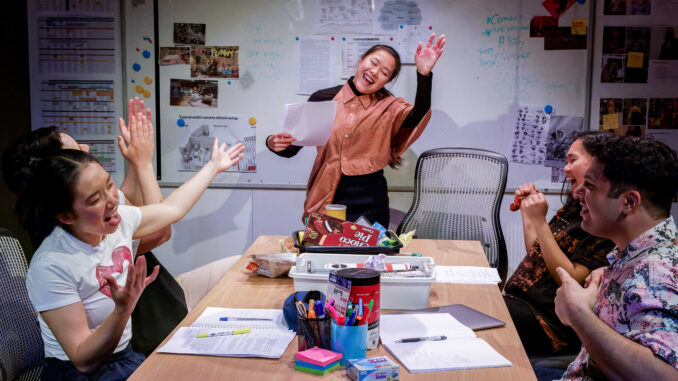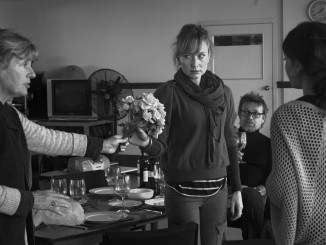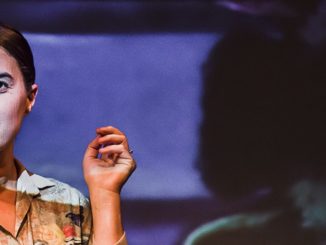
[More than white-hot rage]
The First Prime-Time Asian Sitcom is a New Zealand premiere and screenwriter Nahyeon Lee’s (Kainga) theatre debut, billed as a ‘genre-messing’ black comedy. Pre-show marketing denotes a play which interrogates the sitcom writing process and considers the evolution from the TV writers’ room and onto the screen, where characters and narratives are often modified and sanitised for mass-consumption. The play asks ‘given a seat at the table, how much are you willing to compromise everything you stand for?’
I think it’s important to give some context before I go any further in my discussion of the show: I am a South-Asian screenwriter, playwright and stand-up comedian. It is fair to say that not a day goes by when I don’t consider my intersectionality and the burden of representing this through the three mediums above.
Comedy, as the perhaps riskier outlier, constantly relies upon the subversion of audience expectations. Yet for some – for many Asian creatives – we veer between discussing trauma, and tropes or stereotypes within our work. When our comedy is written and performed, it can result in satisfying, knowing laughter from other POC – but laughter from Pākeha audience members? It can hit a little differently. There’s the constant worry: what if their only take-away of Asianness is this, or my fifteen second ‘bit?’
Apparently, I should care less. I’ve been belittled by members of the comedy community on multiple occasions, told to lighten up. Loosen up. Not be so political.
My every waking moment is political. That’s the nature of working in the arts as an intersectional creative. I’m usually asked to review and comment on work by POC and queer artists, whether in the drama or comedy space, because I’m often one of the few reviewers with this lens.
Reviewing The First Prime-Time Asian Sitcom is a sensible fit, but more so given my experience as an Asian voice in the TV creation process – formally known as the writers’ room. Over the last thirteen years of my career and education, I’ve grappled with questions both academically and personally on the topic of ‘representation,’ of ‘writing and responsibility.’ Schooled by solely white academics and writers’ rooms, I was told at one point that my point of view was wrong, too concerned with the innate crossover between identity and writing. According to that white male, the writer has no responsibility.
Enter Nahyeon Lee. Discourse around the play has built steadily over the last six or so months. I am looking forward to the production. Keen to support PASC (Pan-Asian Screen Collective) member Nahyeon Lee, with direction from Ahi Karunaharan, and performances by actors I’ve seen and enjoyed before – I am ready to enjoy myself.
The audience settles opposite three stage spaces: the writers’ room (complete with headshots and post-it notes of scenes, surrounding a whiteboard), a central ‘living space’, and a ‘The Lucky Cat’ bar area with a sparking blue back-drop.
The Showrunner (Dawn Cheong) gives a somewhat nervous introduction to us, the ’live-taping sitcom audience’, then settles behind a bank of monitors to supervise her creation as it comes to life. The sitcom cast – Ariadne Baltazar, Uhyoung Choi, Jehangir Homavazir and Jess Hong – take on peppy, over-the-top caricatures, all satirising the sitcom genre with its canned laughter and wooden sets.
Interestingly, and thankfully, the audience don’t always laugh on cue at the same jokes as the canned laughter. The ‘staged’ laughter often punctuates iffy stereotyped moments, and is the first demonstration of excellent sound from the design team (John Verryt, Paige Pomana, Minsoh Choi, Jennifer Lal, Natasha Ovely).
A dozen or so scenes fly by. Entitled newcomer Angela (Jess Hong) is in her ‘20s rebellious phase’ and wants to move-in to the flat-share, leading to ‘will-they-won’t-they’ antics between her and the two men. The scenes are peppered with stereotyping, e.g. ham-acting during a discussion over the much-too-frequent use of the word ‘sorry.’
Then a jibe from Angela, dismissing Dev (Jehangir Homavazir) as part of the diaspora because he’s Indian, makes me pull up. In the UK, South-Asian is Asian; it’s only here, in Australia and New Zealand, where I’ve encountered ‘othering’ like this. This is the first moment in The First Prime-Time Asian Sitcom which hits a nerve. It is punchy, and glorious from a writerly perspective, and stomach twisting on a personal level.
This tension builds, with stellar performances from all four ‘sitcom’ members, and leads to a sincere moment between Ariadne Baltazar and Jehangir Homavazir as they dissect the snub. Ariadne’s drunk-acting looks set to steal the show for me – but is followed by the silent performance of Dawn Cheong after the ‘sitcom’ taping stops. I have never witnessed a performer command the stage like this. Empathising with the weight of this moment, as she reflects on her complicity in creating something so compromised, I find myself holding my breath.
Then we move into a second phase of The First Prime-Time Asian Sitcom. An opaque curtain is drawn over the set, and the five performers make their way downstage for a panel discussion to reflect on the ‘sitcom taping.’ The four core cast take on other roles – ‘industry experts’ so to speak, to dissect the pros and cons of the Showrunner’s creation. The ensemble are fierce, working together with tight timing no doubt honed by Ahi Karunaharan’s impeccable direction.
Without alluding to spoilers, the discourse is full of conflict, contradictory opinions and personality clashes caused by what feels like the near-impossible task of creating media in Aotearoa which is fit for mass white consumption and represents Asianness – without boiling it down to stereotypes.
Following this we move into the third ‘act’ – the Writers’ Room – where the Showrunner feels able to speak freely. To argue with her creatives, to drop her guard. In the play’s closing moments, frenetic energy reaches a fever pitch. As the action and sound builds, I feel spoken to directly as both a writer and comedian. We are told to ‘Make Them Laugh.’ Song, choreography and performances are claustrophobic; aggressive; demanding; critiquing.
Finding myself with Jehangir Homavazir directly opposite me, I want so badly to be free from his eyes. Yes, on some level I know it is dark and he probably can’t see my reaction but I feel held accountable. The cast are performing a call to action to the creatives watching – and to viewers who gobble up racism, no questions asked. They are giving an order: not to be complicit anymore.
I cry in a way that makes it hard to breathe. Afraid I’m struggling with my sensory processing disorder, triggered by the lights and sound, my friend squeezes my arm. I show my face, dripping with tears. I tell her, as the lights lift, that I felt like the last twenty or so minutes had been a slow strangle, bringing everything I’ve encountered and suppressed during my TV career to the surface.
The high-powered Exec producer who dismissed me when I asked but where in India is this man from? I was told Mumbai and rural India – as if they were the same. To them, they were. Both serviced their desire to create a villainous, mustache-twirling evil brown man. Unsurprisingly – a disruptor – I was let go.
Then there were microaggressions from Asian TV colleagues: the time I overheard my name described as ‘not even a name.’ As so cleverly explored within the play and Nathan Joe’s show notes for Pantograph Punch, these moments of ‘Asian v.s. Asian’ are the ‘voices you can’t shrug off as simply not getting it.’
Which brings me to my final thoughts. An Asian creative recently challenged me to offer up regular criticisms in my reviews, that I am doing productions a disservice if I don’t. So here goes.
The ‘Lucky Cat’ set, only used once in a filming block? Unheard of! What kind of wacky, unrealistic budget has Nahyeon’s version of TVNZ thrown at this pilot?
The resounding feeling I’ve had for the last two days – longer than I’ve allowed myself to write any review – is that The First Prime-Time Asian Sitcom was an exceptional piece of art that demands reflection more than a blow-by-blow ‘review.’ I’ve been challenged by that slow suffocating feeling again because I can’t pretend any more. Can any of us? It’s not a feeling we can, nor should, ever shake off.
This industry – small yet over-saturated, with creatives starved for funding, support and recognition – is incendiary. Nahyeon has tossed a match into it.
I, no doubt along with countless other creatives, applaud her wholeheartedly. She has put her head above the parapet, acknowledging in the show notes that ‘This could be my first and last play with a mainstream theatre company.’ She was able to articulate the experiences of so many before her – and that tired phrase, ‘the burden of representation’ which still exists even when there is more than one ‘minority’ voice in the room.
I believe this play needs a re-mount, in a larger theatre, and to enter the canon of New Zealand plays. We say it at the end of (most) reviews – ‘Go see this show’ – but this time I want you to see it if you’re a creative, of any kind.
If you’ve ever laughed at a joke told by someone who’s different to you.
If you want to understand what it feels like to have none of the answers, and all of the rage.
The First Prime-Time Asian Sitcom plays Q Loft 3 – 27th November, 2022.




Leave a Reply